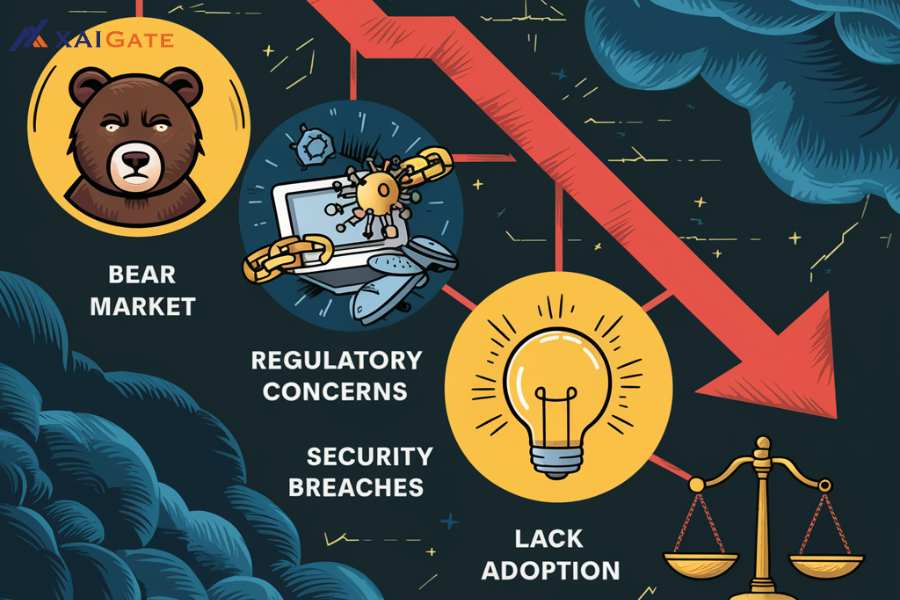Contents
- 1 1. Why cryptocurrency market is down today- Factors Contributing to the Market Decline
- 2 2. Brief overview of the current state of the cryptocurrency market
- 3 3. Factors Contributing to the Market Decline
- 4 4. Market Performance Analysis
- 5 5. Investor Sentiment and Behavior
- 6 6. Steps to Navigate the Crypto Market
- 7 7. Conclusion
1. Why cryptocurrency market is down today- Factors Contributing to the Market Decline
The current downturn in the cryptocurrency market can be attributed to several factors. One of the key reasons is regulatory uncertainty, particularly with the potential for future restrictions in major markets such as the United States and China, which may erode investor confidence. Macroeconomic challenges, such as rising inflation and changes in interest rates, can also discourage investors from allocating funds to riskier assets like Bitcoin and altcoins. Furthermore, negative reports or speculation about leading cryptocurrency platforms, as well as concerns over privacy breaches, can lead to a lack of trust and result in sell-offs, further exacerbating price declines.

2. Brief overview of the current state of the cryptocurrency market
-
The cryptocurrency market is currently on a downward trend, with both market capitalization and trading volume falling to low levels. This decline reflects a reduction in market participants and a loss of investor confidence. Global economic factors, especially rising inflation, are influencing trading behaviors, while tougher regulatory measures in developed economies have intensified uncertainty among investors. Despite these challenges, advancements in technology and the growing adoption of blockchain across various industries continue to reshape the market.
-
Currently, the slump in cryptocurrency can be attributed to multiple factors, with stringent government regulations being the most prominent. These regulatory restrictions are discouraging investment and raising doubts about the market’s future. In addition, inflationary pressures and increasing interest rates make high-risk assets like Bitcoin less appealing to profit-driven investors, further driving down coin values. Furthermore, recent security breaches on major crypto platforms have eroded trust, leading key investors to withdraw from the space.
3. Factors Contributing to the Market Decline
A recent slump in the cryptocurrency market stems from an amalgamation of increased regulatory supervision, reduced crypto ETF excitement, and a series of liquidations in long positions. Given particularly concerning Ethereum ETF-related regulatory delays and huge outflows from these products, bearish sentiment is prevailing. Also, forced selling from leveraged positions has triggered a wave of liquidations that worsened an already bad market downturn (Cointelegraph) (CoinNews | Unbiased Crypto News.) (TradingView).

Mt. Gox Bitcoin Transfer:
- A market shakeup has emerged following the transfer of $9 billion in Bitcoin from Mt. Gox wallets, sparking fears of large-scale sell-offs. The movement has heightened concerns over volatility, shaken investor sentiment, and contributed to a downturn in cryptocurrency prices (Investing.com) (Investing).
- The recent transfer of $9 billion in Bitcoin from Mt. Gox wallets has rattled the market, with investors fearing a potential sell-off. This massive movement has intensified concerns about sharp price volatility and the likelihood of further declines in Bitcoin’s value, deepening uncertainty across the crypto marketplace (Investing.com) (Investing.com).
Slowing Inflows of U.S. Spot Bitcoin ETFs:
- Inflows into U.S. spot Bitcoin ETFs have been slowing down, reflecting diminishing investor enthusiasm as the initial buzz surrounding their debut gradually fades. This deceleration has sparked concerns about whether the broader market can maintain its earlier momentum, making investors more cautious in their approach to allocating capital (Investing.com) (Investing.com).
- The latest figures reveal that U.S. spot Bitcoin exchange-traded funds have recorded net capital outflows, with as much as $78 million withdrawn in a single day. These sizeable redemptions reflect fading investor confidence and shrinking capital inflows, serving as a cautionary signal of growing doubts over the market’s ability to sustain its upward trajectory (TradingView) (Investing.com).

Market Volatility and Unmet Expectations:
- With investors speculating on the forthcoming Dencun upgrade and the next Bitcoin halving, market volatility has intensified notably. Expectations are running high that these events will drive substantial price shifts, yet there is also the possibility that unmet or delayed outcomes could instead amplify uncertainty and trigger further instability in the market (Investing.com) (Investing.com).
- The U.S. SEC’s recent decisions to postpone or reject approvals for ETH ETFs have intensified market volatility, as many investors had expected these products to attract significant inflows. The disappointment of those expectations has dampened trading sentiment and injected additional uncertainty, pressuring Ethereum’s price while also undermining overall confidence in the broader market (Investing.com) (Investing.com).

Macro Economic Factors:
- Cryptocurrency markets are heavily influenced by macroeconomic factors, among which is the Federal Market Committee’s position on interest rates. Thus, changing interest rates may have an effect on how funds are moved and what people think about the market, thereby determining the overall performance of these digital resources.
- Cryptocurrency markets can be extensively impacted by macroeconomic aspects, such as how investors respond in case there is no lowering of the interest rates. The possibility that the scope of using these might be affecting the rates of demand and value of digital assets will depend on their expectations regarding interest rate hikes and low rates remaining for a long period.

4. Market Performance Analysis
-
An in-depth review of Bitcoin and Ethereum price trends generally requires an evaluation of overall market performance. For investors to anticipate future developments, it is essential to study both historical data and current market conditions surrounding cryptocurrencies.
-
A comparative analysis between Bitcoin and other leading digital assets forms the foundation of such market assessments. This approach highlights relative strengths and weaknesses, thereby offering a more accurate picture of market dynamics and uncovering potential investment opportunities.
5. Investor Sentiment and Behavior
Investor emotions and behaviors are pivotal in determining cryptocurrency markets because they are often dictated by emotions and perceptions. Positive feelings about the market could lead to increased purchase, whereas unfavorable sentiments may cause sell-offs or volatile prices. By recognizing these behavioral tendencies, investors can predict market movements and thereby make rational decisions.
- Fear and Greed Index:
The Fear and Greed Index depicts current market emotions in which investor sentiment and actions are evaluated. Extreme greed is indicated by high index scores – these may indicate overpriced assets; while low index scores tend to mean fear; therefore making it an opportunity for purchase.
- Recent ETF Outflows:
Profoundly influencing investor sentiment and behavior may be the data on flows from various bitcoin ETF. By analysis of such flows information concerning investor confidence and trends in the market are obtained, thus aiding to predict changes in those two parts (market dynamics and market emotion).
The cryptocurrency market is heavily influenced by investor sentiment and behavior. Oftentimes, trading decisions are based on emotions. By examining these behaviors, we can foresee how the market will move, where increased buying and rallies occur during positive sentiments but selling and falling markets are spurred by negativity.

6. Steps to Navigate the Crypto Market
When it comes to working in the cryptocurrency market, your approach must be meticulous. This includes doing extensive research, keeping an eye on the trends in the market, as well as diversifying your investments. What is more, risk management strategies and clearly stated monetary objectives can help mitigate fluctuations and maximize paybacks.
- Choosing Cryptocurrencies:
Navigating the crypto ecosystem is such a difficult task because it requires a deeper understanding of things which requires extensive research. It is possible for investors to make smart choices and avoid losses in this unstable environment by assessing the technology, application, and place on the market of these assets.
- Selecting a Crypto Exchange:
To traverse the crypto market capably, obtaining a trustworthy exchange for trading is one of the most significant processes. It entails investigating platforms concerning their security measures, charges as well as user opinions so as to ensure safety alongside user-friendly trading processes.
- Investment Process:
The first step in investing in cryptocurrencies typically involves meeting Know Your Customer (KYC) requirements, which include verifying your identity for regulatory compliance. Additionally, it’s important to understand the available payment methods, such as bank transfers, credit cards, or digital wallets, to securely and conveniently fund your investment account.
When investing in cryptocurrencies, the process usually includes exchanging digital assets and ensuring secure storage. For enhanced security, it’s recommended to use hardware wallets or other secure storage solutions to protect your investments from hacking and theft.
7. Conclusion
Today, the drop in the cryptocurrency market is a result of many reasons including regulatory crackdowns, natural corrections in the market, global economic uncertainties and technological problems. The outcome of all this is that the investor will be less confident and more uncertain. Therefore it is important to understand these dynamics so as to navigate through the inherent risks associated with crypto markets. When investors know what is happening around them, they can make better decisions.









